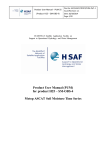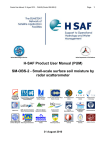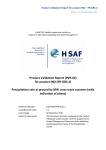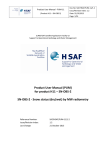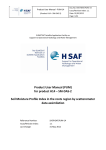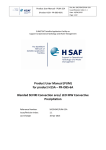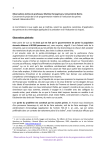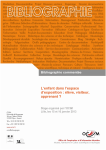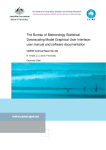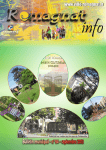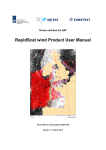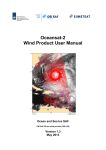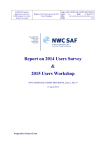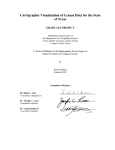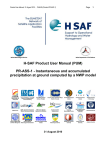Download Product User Manual - H-SAF
Transcript
Product User Manual - PUM-25 (Product H25 – SM-OBS-4) Doc.No: SAF/HSAF/CDOP2/PUM-25/0.7 Issue/Revision Index: 0.9 Date: 13/02/2014 Page: 1/21 EUMETSAT Satellite Application Facility on Support to Operational Hydrology and Water Management Product User Manual (PUM) for product H25 – SM-OBS-4 Metop ASCAT Soil Moisture Time Series Product User Manual - PUM-25 (Product H25 – SM-OBS-4) Doc.No: SAF/HSAF/CDOP2/PUM-25/0.7 Issue/Revision Index: 0.9 Date: 13/02/2014 Page: 2/21 DOCUMENT CHANGE RECORD Issue / Revision Date Description Prepared by 0.1 2013/07/25 Document created. S. Hahn 0.2 2013/09/23 Major revision of the document. S. Hahn 0.3 2013/10/01 Updated section 3. S. Hahn 0.4 2013/10/04 Revision of the complete document. S. Hahn 0.5 2013/10/07 Revised document format S. Hahn, S. Hasenauer 0.6 2013/10/16 Updated product introduction and characteristics. S. Hasenauer 0.7 2013/10/21 Version prepared for delivery of product in demonstrational status Project Management Team 0.8 2014/02/07 Minor updates in section product availability S. Hasenauer 0.9 2014/02/13 Minor changes in headlines, page breaks, links S. Hasenauer Product User Manual - PUM-25 (Product H25 – SM-OBS-4) Doc.No: SAF/HSAF/CDOP2/PUM-25/0.7 Issue/Revision Index: 0.9 Date: 13/02/2014 Page: 3/21 INDEX Introduction ........................................................................................................................................ 5 1.1 Purpose of the document ........................................................................................................... 5 1.2 Relevant staff associated to the User Service and to product SM-OBS-4 ................................. 5 2 Product description ............................................................................................................................. 6 2.1 Product parameters .................................................................................................................... 6 2.2 Product resolution and grid........................................................................................................ 7 2.3 Structure and format of the product ........................................................................................... 8 2.3.1 Data file format and file naming ........................................................................................... 8 2.3.2 NetCDF file structure .......................................................................................................... 10 2.3.3 Example NetCDF file .......................................................................................................... 14 2.4 Product change log .................................................................................................................. 15 2.5 Data Citation ............................................................................................................................ 16 3 Product validation ............................................................................................................................ 17 4 Product availability .......................................................................................................................... 17 4.1 Site ........................................................................................................................................... 17 4.2 Conditions for use .................................................................................................................... 17 5 Reference documents ....................................................................................................................... 17 6 References ........................................................................................................................................ 17 Annex 1 - Introduction to H-SAF............................................................................................................. 19 Annex 2 – Acronyms................................................................................................................................ 20 1 Product User Manual - PUM-25 (Product H25 – SM-OBS-4) Doc.No: SAF/HSAF/CDOP2/PUM-25/0.7 Issue/Revision Index: 0.9 Date: 13/02/2014 Page: 4/21 List of Tables Table 1: Relevant persons associated to the User service and to product SM-OBS-4 ............................... 5 Table 2 Overview of product parameters. .................................................................................................. 7 Table 3 Global NetCDF Attributes .......................................................................................................... 11 Table 4 Attribute table for variable gpi .................................................................................................... 11 Table 5 Attribute table for variable lon .................................................................................................... 11 Table 6 attribute table for variable lat ...................................................................................................... 11 Table 7 Attribute table for variable row_size ........................................................................................... 11 Table 8 Attribute table for variable jd ...................................................................................................... 11 Table 9 Attribute table for variable sm .................................................................................................... 12 Table 10 Attribute table for variable sm_noise ........................................................................................ 12 Table 11 Attribute table for variable orbit_dir ......................................................................................... 12 Table 12 Attribute table for variable proc_flag ........................................................................................ 12 Table 13 Attribute table for variable por_gldas ....................................................................................... 12 Table 14 Attribute table for variable por_hwsd ....................................................................................... 13 Table 15 Attribute table for variable ssf ................................................................................................... 13 Table 16 Attribute table for variable frozen ............................................................................................. 13 Table 17 Attribute table for variable snow............................................................................................... 13 Table 18 Attribute table for variable wetland .......................................................................................... 14 Table 19 Attribute table for variable topo ................................................................................................ 14 Table 20 Attribute table for variable doy ................................................................................................. 14 Table 21 Product change log. ................................................................................................................... 16 List of Figures Figure 1: Screenshot of the DGG point locator.......................................................................................... 8 Figure 2: 5x5 degree cell partitioning of the grid points. The upper number in each cell represents the cell number and the lower number the number of grid points in this cell. ............................... 9 Figure 3 An example of a NetCDF file using the software ncBrowse. The left image shows ncBrowse after opening the NetCDF file and the right image shows all dimensions (top), attributes (middle) and variables (bottom) in a table view. .................................................................... 14 Figure 4: Time series plot of all available variables at a grid point in Slovenia, plotted with the pytesmo software .................................................................................................................................. 15 Figure 6 Current composition of the EUMETSAT SAF Network (in order of establishment) ............... 19 Figure 5 Conceptual scheme of the EUMETSAT Application Ground Segment .................................... 19 Product User Manual - PUM-25 (Product H25 – SM-OBS-4) 1 1.1 Doc.No: SAF/HSAF/CDOP2/PUM-25/0.7 Issue/Revision Index: 0.9 Date: 13/02/2014 Page: 5/21 Introduction Purpose of the document Product User Manuals are available for each (pre)-operational H-SAF product, for open users, and also for demonstrational products, as necessary for beta-users. Each PUM contains: • Product introduction: principle of sensing, Satellites utilized, Instrument(s) description, Highlights of the algorithm, Architecture of the products generation chain, Product coverage and appearance; • Main product operational characteristics: Horizontal resolution and sampling, Observing cycle and time sampling, Timeliness; • Overview of the product validation activity: Validation strategy, Global statistics, Product characterisation • Basic information on product availability: Access modes, Description of the code, Description of the file structure An annex also provides common information on Objectives and products, Evolution of H-SAF products, User service and Guide to the Products User Manual. Although reasonably self-standing, the PUM’s rely on other documents for further details. Specifically: • ATDD (Algorithms Theoretical Definition Document), for extensive details on the algorithms, only highlighted here; • PVR (Product Validation Report), for full recount of the validation activity, both the evolution and the latest results. These documents are structured as this PUM, i.e. one document for each product. They can be retrieved from the CNMCA site on HSAF web page at User Documents session. On the same site, to obtain user and password please contact the Help Desk) it is interesting to consult, although not closely connected to this PUM, the full reporting on hydrological validation experiments (impact studies): • HVR (Hydrological Validation Report), spread in 10 Parts, first one on requirements, tools and models, then 8, each one for one participating country, and a last Part with overall statements on the impact of H-SAF products in Hydrology. 1.2 Relevant staff associated to the User Service and the product Table 1 records the names of the persons associated to the development and operation of the User service and of product SM-OBS-4. Table 1: Relevant persons associated to the User service and to product SM-OBS-4 Product Development Team Wolfgang Wagner (Leader) Technische Universität Wien (TU-Wien), Stefan Hasenauer Department of Geodesy and Geoinformation Sebastian Hahn Thomas Melzer [email protected] Austria [email protected] [email protected] [email protected] Product User Manual - PUM-25 (Product H25 – SM-OBS-4) Christoph Paulik Christoph Reimer Product Operations Team Barbara Zeiner Zentralanstalt für Meteorologie und Geodynamik (Leader) (ZAMG) 2 Doc.No: SAF/HSAF/CDOP2/PUM-25/0.7 Issue/Revision Index: 0.9 Date: 13/02/2014 Page: 6/21 [email protected] [email protected] Austria [email protected] Product description The surface soil moisture data (SSM) are retrieved from the radar backscattering coefficients measured by the ASCAT (Advanced Scatterometer) onboard the Metop satellite (Figa-Saldaña et al. 2002) using a change detection method, developed at the Research Group Remote Sensing, Department for Geodesy and Geoinformation (GEO), Vienna University of Technology (TU-Wien). In the TU-Wien model, long-term Scatterometer data are used to model the incidence angle dependency of the radar backscattering signal. Knowing the incidence angle dependency, the backscattering coefficients are normalised to a reference incidence angle. Finally, the relative soil moisture data ranging between 0% and 100% are derived by scaling the normalised backscattering coefficients between the lowest/highest values corresponding to the driest/wettest soil conditions. The derived soil moisture product represents the content in the first 5 cm of the soil in relative units between totally dry conditions and total water capacity. The unit is degree of saturation [%], but can be converted into volumetric units [m3m-3] with the help of soil porosity information. More information on the retrieval algorithm can be found in the Algorithmic Theoretical Baseline Document (ATBD) [RD-2] and in Wagner et al. (1999) and Naeimi et al. (2009). 2.1 Product parameters The product is composed of several parameters (geophysical parameters, flags, geo-location information, etc.), which are described in the following Table 2. Parameter Description Grid point index The grid point index (GPI) is a unique identifier for each single grid point. Latitude Latitude position of the GPI in degrees. Longitude Longitude position of the GPI in degrees. Row size The number of observations per GPI is indicated by the row size or in other words the length of the time series per GPI. A detailed description on how this is important for reading the time series data is given in section 2.3.2.1. Time The time parameter represents the time stamp for the measurements. It is defined as the days since 1970-01-01 00:00:00. Soil moisture Soil moisture represents the water content in the first 0-5 cm of the soil in relative units between totally dry conditions and total water capacity. The unit is degree of saturation [%]. A conversion from degree of saturation (%) to absolute units (m3 m-3) is possible by using the porosity values (see equation below). Soil moisture noise An estimate of the uncertainty of soil moisture is given in the parameter soil moisture noise. The unit is degree of saturation [%]. Porosity (LDAS) The porosity is a measure of the void spaces in the soil and defined as the fraction of the volume of voids over the total volume. The parameter is given in m3 m-3 and can be used to transform the relative soil moisture % into absolute units m3 m-3. Product User Manual - PUM-25 (Product H25 – SM-OBS-4) Doc.No: SAF/HSAF/CDOP2/PUM-25/0.7 Issue/Revision Index: 0.9 Date: 13/02/2014 Page: 7/21 This parameter was resampled from the soil porosity used in the Land Data Assimilation System (LDAS) dataset (Reynolds 2000) by NASA. Porosity (HWSD) See porosity description above. This parameter was derived using soil information from the Harmonized World Soil Database (HWSD) (FAO/IIASA/ISRIC/ISSCAS/JRC 2012) by applying the formulas of Saxton and Rawls (2006) Orbit direction The orbit direction indicates the movement of the spacecraft through the plane of reference. The ascending direction represents a movement north through the plane of reference, and the descending south through the plane of reference. Processing flag The processing flags comprise information about internal quality checks and specific processing details. Surface state flag The Surface State Flag (SSF) indicates the surface conditions: unknown, unfrozen, frozen, temporary melting/water on the surface or permanent ice. Frozen probability This frozen probability flag is built on a historic analysis of modelled climate data (ERA-40, Uppala et al. (2005)) and gives the probability for the frozen soil/canopy conditions for each day of the year. Snow probability This snow probability flag is built on a historic analysis of SSM/I snow cover data and gives the probability for the occurrence of snow for any day of the year. Inundation and wetland fraction The fraction coverage of inundated and wetland areas are derived from a combined analysis of the Global Lakes and Wetlands Database (GLWD) Level 3 product (2004) and the Global Self-consistent, Hierarchical, High-resolution Shoreline database GSHHS (v1.5, 2004) which includes several wetland and inundation types. Topographic complexity The topographic complexity flag is derived from the GTOPO30 data. The standard deviation of elevation is calculated and globally normalized between 0 and 100. Table 2 Overview of product parameters. A conversion from degree of saturation (%) to absolute units (m3 m-3) is possible by multiplying with porosity: s θ=p∙ 100 where θ is absolute soil moisture in m3 m-3, p is porosity in m3 m-3 and s is degree of saturation (%). As it can be seen in this equation, the accuracy of soil porosity is as import as the relative soil moisture content. 2.2 Product resolution and grid The spatial resolution of the product is 25x25 km and based on the WARP 5 grid [RD-1]. The WARP 5 grid represents a discrete global grid (DGG) with a grid spacing of 12.5 km. In total, there are 3264391 grid points, where 839826 are land points. The location of the points can be viewed interactively with the internet browser tool "DGG Point Locator" (Figure 1) at the following location: http://www.ipf.tuwien.ac.at/radar/dv/dgg Product User Manual - PUM-25 (Product H25 – SM-OBS-4) Doc.No: SAF/HSAF/CDOP2/PUM-25/0.7 Issue/Revision Index: 0.9 Date: 13/02/2014 Page: 8/21 Figure 1: Screenshot of the DGG point locator. 2.3 2.3.1 Structure and format of the product Data file format and file naming The product is provided as time series on a global discrete grid (DGG) stored in NetCDF-4. All files follow the NetCDF Climate and Forecast (CF) Metadata Conventions version 1.6 [RD-3]. The grid points are organised in cells, in order to reduce the number of files. The cell size is defined as 5 x 5 degree and does contain up to 2000 grid points, mainly depending on the latitude. The cell number and the number of grid points per cell are shown in Figure 2. Product User Manual - PUM-25 (Product H25 – SM-OBS-4) Doc.No: SAF/HSAF/CDOP2/PUM-25/0.7 Issue/Revision Index: 0.9 Date: 13/02/2014 Page: 9/21 Figure 2: 5x5 degree cell partitioning of the grid points. The upper number in each cell represents the cell number and the lower number the number of grid points in this cell. A look-up containing GPI cell number, longitude and latitude can be found in this file: TUW_WARP5_grid_info_<version>.nc The file naming is: TUW_METOP_ASCAT_<version><release>_<cell>.nc A NetCDF file for cell number 234 of product version WARP5.5 R1.2 looks like this: TUW_METOP_ASCAT_WARP55R12_0234.nc Product User Manual - PUM-25 (Product H25 – SM-OBS-4) 2.3.2 Doc.No: SAF/HSAF/CDOP2/PUM-25/0.7 Issue/Revision Index: 0.9 Date: 13/02/2014 Page: 10/21 NetCDF file structure 2.3.2.1 Contiguous ragged array representation of time series The time series are stored in the contiguous ragged array representation defined by the NetCDF Climate and Forecast (CF) Metadata Conventions version 1.6 [RD-3]. The time series parameters (like soil moisture, soil moisture noise) are associated with the coordinate values time(obs), lat(i) and lon(i), where i indicates which time series. The time series i comprises the following data elements: rowStart(i) to rowStart(i) + row_size(i)-1 where rowStart(i) = 0 if i = 0 rowStart(i) = rowStart(i-1) + row_size(i-1) if i > 0 The variable row_size is the count variable containing the length of each time series feature. It is identified by having an attribute with name sample_dimension whose value is name of the sample dimension (obs in this case). The auxiliary coordinate variables lat and lon are GPI variables. 2.3.2.2 Global NetCDF attributes In general the global attributes will be static and do not vary between files for the same file version containing the same product version, with the exception of those attributes whose content is noted by a variable (denoted as <variable>). The Global NetCDF attributes are described in Table 3. Global Attribute Name Content title Metop ASCAT Soil Moisture Time Series institution Vienna University of Technology source Metop ASCAT Level 1b 25km backscatter Conventions CF-1.6 product_version <product version> id <filename> date_created <file creation date> creator_url http://rs.geo.tuwien.ac.at/ project H-SAF geospatial_lat_min <lat min> geospatial_lat_max <lat max> geospatial_lon_min <lon min> geospatial_lon_max <lon max> time_coverage_start 20070101T000000Z time_coverage_ed 20130712T000000Z platform Metop-A sensor ASCAT geospatial_lon_resolution 12.5 km geospatial_lat_resolution 12.5 km Product User Manual - PUM-25 (Product H25 – SM-OBS-4) Doc.No: SAF/HSAF/CDOP2/PUM-25/0.7 Issue/Revision Index: 0.9 Date: 13/02/2014 Page: 11/21 Table 3 Global NetCDF Attributes 2.3.2.3 NetCDF variables and attributes The rest of the file attributes is described in the following tables. NetCDF Attribute Description long_name Grid Point Index cf_role timeseries_id coordinates lat lon valid_range [0, 3264390] Table 4 Attribute table for variable gpi NetCDF Attribute Description standard_name longitude long_name grid point longitude units degree_east valid_range [-180.0, 180.0] Table 5 Attribute table for variable lon NetCDF Attribute Description standard_name latitude long_name grid point latitude units degree_north valid_range [-90.0, 90.0] Table 6 attribute table for variable lat NetCDF Attribute Description sample_dimension obs long_name Number of observations for this grid point Table 7 Attribute table for variable row_size NetCDF Attribute Description standard_name Time long_name Time of measurement coordinates time lat lon Table 8 Attribute table for variable jd NetCDF Attribute Description long_name Soil Moisture units % coordinates time lat lon Product User Manual - PUM-25 (Product H25 – SM-OBS-4) valid_range [0, 100] missing_value -1 Doc.No: SAF/HSAF/CDOP2/PUM-25/0.7 Issue/Revision Index: 0.9 Date: 13/02/2014 Page: 12/21 Table 9 Attribute table for variable sm NetCDF Attribute Description long_name Soil Moisture Noise units % coordinates time lat lon valid_range [0, 100] missing_value -1 Table 10 Attribute table for variable sm_noise NetCDF Attribute Description long_name Orbit direction coordinates time lat lon Table 11 Attribute table for variable orbit_dir NetCDF Attribute Description long_name Processing flag flag_values 0, 1, 2, 4, 8, 16 coordinates time lat lon flag_meanings • default • soil_moisture_set_to_0_since_it_was_between_0_and_-50 • soil_moisture_set_to_100_it_was_between_100_and_150 • soil_moisture_set_to_NaN_it_was_below_-50 • soil_moisture_set_to_NaN_it_was_above_150 • normalised_backscatter_is_out_of_limits_or_dry_wet_reference_is_NaN valid_range [0, 16] missing_value -1 Table 12 Attribute table for variable proc_flag NetCDF Attribute Description long_name Porosity resampled from NASA’s LDAS units m3 m-3 coordinates lat lon valid_range [0, 1] missing_value -1 Table 13 Attribute table for variable por_gldas Product User Manual - PUM-25 (Product H25 – SM-OBS-4) NetCDF Attribute Doc.No: SAF/HSAF/CDOP2/PUM-25/0.7 Issue/Revision Index: 0.9 Date: 13/02/2014 Page: 13/21 Description long_name Porosity derived from HWSD units m3 m-3 coordinates lat lon valid_range [0, 1] missing_value -1 Table 14 Attribute table for variable por_hwsd NetCDF Attribute Description long_name Surface State Flag flag_values 0, 1, 2, 3, 4 coordinates time lat lon flag_meanings • unknown • unfrozen • frozen_temporary • melting_water_on_the_surface • permanent_ice valid_range [0, 4] missing_value -1 Table 15 Attribute table for variable ssf NetCDF Attribute Description long_name Frozen probability units % coordinates doy lat lon valid_range [0, 100] missing_value -1 Table 16 Attribute table for variable frozen NetCDF Attribute Description long_name Snow probability units % coordinates doy lat lon valid_range [0, 100] missing_value -1 Table 17 Attribute table for variable snow NetCDF Attribute long_name Description Inundation and wetland fraction Product User Manual - PUM-25 (Product H25 – SM-OBS-4) units % coordinates lat lon valid_range [0, 100] missing_value -1 Doc.No: SAF/HSAF/CDOP2/PUM-25/0.7 Issue/Revision Index: 0.9 Date: 13/02/2014 Page: 14/21 Table 18 Attribute table for variable wetland NetCDF Attribute Description long_name Topographic complexity units % coordinates lat lon valid_range [0, 100] missing_value -1 Table 19 Attribute table for variable topo NetCDF Attribute Description long_name Day of year units days Table 20 Attribute table for variable doy 2.3.3 Example NetCDF file An example of the NetCDF product is shown in the following Figure 3. The viewer used for this example is ncBrowse, available at: http://www.epic.noaa.gov/java/ncBrowse/ Figure 3 An example of a NetCDF file using the software ncBrowse. The left image shows ncBrowse after opening the NetCDF file and the right image shows all dimensions (top), attributes (middle) and variables (bottom) in a table view. Product User Manual - PUM-25 (Product H25 – SM-OBS-4) Doc.No: SAF/HSAF/CDOP2/PUM-25/0.7 Issue/Revision Index: 0.9 Date: 13/02/2014 Page: 15/21 The netCDF files can also be easily read using the open source python package pytesmo (Toolbox for the Evaluation of Soil Moisture Observations). For more information (installation instructions, documentation, examples and links to the source code) please consult the pytesmo website at: http://rs.geo.tuwien.ac.at/validation_tool/pytesmo/. After Downloading the NetCDF files as well as the grid information NetCDF file to your computer the data can be read with pytesmo and plotted with the matplotlib library using the following example program. The output time series plot is shown in Figure 4. import matplotlib.pyplot as plt import pytesmo.io.sat.ascat as ascat import os ascat_folder = os.path.join(‘path’,’to’,’downloaded’,’NetCDF’,’files’) # path to which you downloaded the NetCDF files ascat_grid_folder = os.path.join(‘path’,’to’,’grid’,’NetCDF’,’file’) #path to the grid file TUW_warp5_grid_info_<version>.nc ascat_SSM_reader = ascat.AscatH25_SSM(ascat_folder, ascat_grid_folder) gpi = 2329253 result = ascat_SSM_reader.read_ssm(gpi) #alternative way using lon, lat #lon = 14.284 #lat = 45.698 #result = ascat_SSM_reader.read_ssm(lon, lat) result.plot() plt.show() Figure 4: Time series plot of all available variables at a grid point in Slovenia, plotted with the pytesmo software 2.4 Product change log The following Table 21 lists the product changes with the most recent version on top. Product version/release WARP5.5 R1.2 Description Extension of time-series 2013-03-01 to 201307-12 Processed: Sep 2013 Algorithm changes Product User Manual - PUM-25 (Product H25 – SM-OBS-4) WARP5.5 R1.1 WARP5.5 R0.1 WARP5.4 R2.2 WARP5.4 R2.1 Reprocessing 2007-01-01 to 2013-02-28 Processed: Mar 2013 Reprocessing 2007-01-01 to 2012-11-30 Processed: Dec 2012 – Jan 2013 Extension of time-series 2011-12-31 to 201205-31 Processed: Jun 2012 Reprocessing 2007-01-01 to 2011-12-31 Processed: Feb 2012 Doc.No: SAF/HSAF/CDOP2/PUM-25/0.7 Issue/Revision Index: 0.9 Date: 13/02/2014 Page: 16/21 Inter-beam calibration of Level 1 backscatter data applied. The criterion for a successful fit to the logistic function during freeze-thaw computation turned out to be too strict, resulting in many invalid SSFs, particularly in the northern regions. The criterion has been relaxed. WARP5.4 R1.4 WARP5.4 R1.3 WARP5.4 R1.2 WARP5.4 R1.1 WARP5.4 R0.1 Extension of time-series (2007-01-01 to 201112-31) Processed: Jan 2012 Extension of time-series 2011-06-11 to 201108-17 Processed: Nov 2011 Extension of time-series 2010-12-31 to 201106-11 Processed: Nov 2011 Reprocessing 2007-01-01 to 2010-12-31 Processed: Nov 2011 Correction of SSF computation. Reprocessing 2007-01-01 to 2010-12-31 Processed: May – Jun 2011 Table 21 Product change log. 2.5 Data Citation The data set should be cited using the complete references as follows: [1] W. Wagner, G. Lemoine, and H. Rott, “A method for estimating soil moisture from ERS scatterometer and soil data,” Remote Sensing of Environment, vol. 70, no. 2, pp. 191–207, 1999. [2] V. Naeimi, K. Scipal, Z. Bartalis, S. Hasenauer, and W. Wagner, “An Improved Soil Moisture Retrieval Algorithm for ERS and METOP Scatterometer Observations,” IEEE Trans. Geosci. Remote Sensing, vol. 47, no. 7, pp. 1999–2013, 2009. [3] V. Naeimi, C. Paulik, A. Bartsch, W. Wagner, R. Kidd, S.-E. Park, K. Elger, and J. Boike, “ASCAT Surface State Flag (SSF): Extracting Information on Surface Freeze/Thaw Conditions From Backscatter Data Using an Empirical Threshold-Analysis Algorithm,” IEEE Transactions on Geoscience and Remote Sensing, 2012. [4] Naeimi, V., Paulik, C., Bartsch, A., Wagner, W., Kidd, R., Park, S.-E., Elger, K., Boike, J. (2012). ASCAT Surface State Flag (SSF): Extracting Information on Surface Freeze/Thaw Conditions From Backscatter Data Using an Empirical Threshold-Analysis Algorithm. IEEE Transactions on Geoscience and Remote Sensing, 50(7), 2566–2582. doi:10.1109/TGRS.2011.2177667 Product User Manual - PUM-25 (Product H25 – SM-OBS-4) 3 Doc.No: SAF/HSAF/CDOP2/PUM-25/0.7 Issue/Revision Index: 0.9 Date: 13/02/2014 Page: 17/21 Product validation Detailed information about product validation can be found in the corresponding Algorithmic Theoretical Baseline Document (ATBD) [RD-2]. 4 4.1 Product availability Site The product is available via FTP. Login details are available after contacting the user help desk at http://hsaf.meteoam.it/ 4.2 Conditions for use All H-SAF products are owned by EUMETSAT, and the EUMETSAT SAF Data Policy applies. They are available for all users free of charge. Users should recognise the respective roles of EUMETSAT, the H-SAF Leading Entity and the H-SAF Consortium when publishing results that are based on H-SAF products. EUMETSAT’s ownership and intellectual property rights into the SAF data and products is best safeguarded by simply displaying the words “© EUMETSAT” under each of the SAF data and products shown in a publication or website. 5 Reference documents [RD-1] WARP 5 grid document, version 0.3, 4 October 2013, Vienna University of Technology, Austria [RD-2] Algorithm Theoretical Baseline Document (ATBD) for product H25/SM-OBS-4 METOP ASCAT Soil Moisture Time Series, version 0.3, 16 October 2013 [RD-3] NetCDF Climate and Forecast (CF) Metadata Conventions: Version 1.6, 5 December, 2011, Brian Eaton, Jonathan Gregory, Bob Drach, Karl Taylor, and Steve Hankin 6 References FAO/IIASA/ISRIC/ISSCAS/JRC (2012). Harmonized World Soil Database (version 1.2) Figa-Saldaña, J., Wilson, J.J.W., Attema, E., Gelsthorpe, R., Drinkwater, M.R., & Stoffelen, A. (2002). The advanced scatterometer (ASCAT) on the meteorological operational (MetOp) platform: A follow on for European wind scatterometers. Canadian Journal of Remote Sensing, 28, 404-412 Naeimi, V., Scipal, K., Bartalis, Z., Hasenauer, S., & Wagner, W. (2009). An improved soil moisture retrieval algorithm for ERS and METOP scatterometer observations. IEEE Transaction on Geoscience and Remote Sensing, 47, 1999-2013 Reynolds, C.A., T. J. Jackson, and W. J. Rawls ( 2000). Estimating soil water-holding capacities by linking the Food and Agriculture Organization soil map of the world with global pedon databases and continuous pedotransfer functions. Water Resour. Res., 36, 9 Product User Manual - PUM-25 (Product H25 – SM-OBS-4) Doc.No: SAF/HSAF/CDOP2/PUM-25/0.7 Issue/Revision Index: 0.9 Date: 13/02/2014 Page: 18/21 Saxton, K.E., & Rawls, W.J. (2006). Soil Water Characteristic Estimates by Texture and Organic Matter for Hydrologic Solutions. Soil Science Society of America Journal, 70, 1569 Uppala, S.M., Kallberg, P.W., Simmons, A.J., Andrae, U., Bechtold, V.D., Fiorino, M., Gibson, J.K., Haseler, J., Hernandez, A., Kelly, G.A., Li, X., Onogi, K., Saarinen, S., Sokka, N., Allan, R.P., Andersson, E., Arpe, K., Balmaseda, M.A., Beljaars, A.C.M., Van De Berg, L., Bidlot, J., Bormann, N., Caires, S., Chevallier, F., Dethof, A., Dragosavac, M., Fisher, M., Fuentes, M., Hagemann, S., Holm, E., Hoskins, B.J., Isaksen, L., Janssen, P., Jenne, R., McNally, A.P., Mahfouf, J.F., Morcrette, J.J., Rayner, N.A., Saunders, R.W., Simon, P., Sterl, A., Trenberth, K.E., Untch, A., Vasiljevic, D., Viterbo, P., & Woollen, J. (2005). The ERA-40 re-analysis. Quarterly Journal of the Royal Meteorological Society, 131, 2961-3012 Wagner, W., Lemoine, G., & Rott, H. (1999). A Method for Estimating Soil Moisture from ERS Scatterometer and Soil Data. Remote Sensing of Environment, 70, 191-207 Product User Manual - PUM-25 (Product H25 – SM-OBS-4) Doc.No: SAF/HSAF/CDOP2/PUM-25/0.7 Issue/Revision Index: 0.9 Date: 13/02/2014 Page: 19/21 Annex 1 - Introduction to H-SAF The EUMETSAT Satellite Application Facilities H-SAF is part of the distributed application ground segment of the “European Organisation for the Exploitation of Meteorological Satellites (EUMETSAT)”. The application ground segment consists of a “Central Application Facility (CAF)” and a network of eight “Satellite Application Facilities (SAFs)” dedicated to development and operational activities to provide satellite-derived data to support specific user communities. See next figure: EUM Geostationary Systems Systems of the EUM/NOAA Cooperation Data Acquisition and Control Data Processing EUMETSAT HQ other data sources Application Ground Segment Meteorological Products Extraction EUMETSAT HQ Archive & Retrieval Facility (Data Centre) EUMETSAT HQ Centralised processing and generation of products Satellite Application Facilities (SAFs) Decentralised processing and generation of products USERS Figure 5 Conceptual scheme of the EUMETSAT Application Ground Segment Next figure reminds the current composition of the EUMETSAT SAF network (in order of establishment). Nowcasting & Very Short Range Forecasting Ocean and Sea Ice Ozone & Atmospheric Chemistry Monitoring Climate Monitoring Numerical Weather Prediction GRAS Meteorology Land Surface Analysis Operational Hydrology & Water Management Figure 6 Current composition of the EUMETSAT SAF Network (in order of establishment) H-SAF objectives and products The H-SAF was established by the EUMETSAT Council on 3 July 2005; its Development Phase started on 1st September 2005 and ended on 31 August 2010. Its first Continuous Development and Operations Phase (CDOP) started on 28 September 2010 and ended on 28 February 2012. The SAF is now in its Second Continuous Development and Operations Phase (CDOP-2) started on 1 March 2012 and will end on 28 February 2017. Product User Manual - PUM-25 (Product H25 – SM-OBS-4) Doc.No: SAF/HSAF/CDOP2/PUM-25/0.7 Issue/Revision Index: 0.9 Date: 13/02/2014 Page: 20/21 The H-SAF objectives are: a. to provide new satellite-derived products from existing and future satellites with sufficient time and space resolution to satisfy the needs of operational hydrology; identified products: • precipitation; • soil moisture; • snow parameters; b. to perform independent validation of the usefulness of the new products for fighting against floods, landslides, avalanches, and evaluating water resources; the activity includes: • downscaling/upscaling modelling from observed/predicted fields to basin level; • fusion of satellite-derived measurements with data from radar and raingauge networks; • assimilation of satellite-derived products in hydrological models; • assessment of the impact of the new satellite-derived products on hydrological applications. Annex 2 – Acronyms ASAR ASAR ASCAT ATDD AU BfG BUFR CAF CC CDA CESBIO CM-SAF CNMCA CNR CNRS CORINE DPC DWD EARS ECMWF Envisat ESA EUM EUMETCast EUMETSAT FMI FTP GEO GMES GRAS-SAF H-SAF IFOV IMWM IR IRM ISAC ITU LATMOS Advanced Synthetic Aperture Radar (on Envisat) GM ASAR Global Mode Advanced Scatterometer (on MetOp) Algorithms Theoretical Definition Document Anadolu University (in Turkey) Bundesanstalt für Gewässerkunde (in Germany) Binary Universal Form for the Representation of meteorological data Central Application Facility (of EUMETSAT) Correlation Coefficient Command and Data Acquisition station Centre d'Etudes Spatiales de la BIOsphere (of CNRS, in France) SAF on Climate Monitoring Centro Nazionale di Meteorologia e Climatologia Aeronautica (in Italy) Consiglio Nazionale delle Ricerche (of Italy) Centre Nationale de la Recherche Scientifique (of France) COoRdination of INformation on the Environment Dipartimento Protezione Civile (of Italy) Deutscher Wetterdienst EUMETSAT Advanced Retransmission Service European Centre for Medium-range Weather Forecasts Environmental Satellite European Space Agency Short for EUMETSAT EUMETSAT’s Broadcast System for Environmental Data European Organisation for the Exploitation of Meteorological Satellites Finnish Meteorological Institute File Transfer Protocol Geostationary Earth Orbit Global Monitoring for Environment and Security SAF on GRAS Meteorology SAF on Support to Operational Hydrology and Water Management Instantaneous Field Of View Institute of Meteorology and Water Management (in Poland) Infra Red Institut Royal Météorologique (of Belgium) (alternative of RMI) Istituto di Scienze dell’Atmosfera e del Clima (of CNR, Italy) İstanbul Technical University (in Turkey) Laboratoire Atmosphères, Milieux, Observations Spatiales (of CNRS, in France) Product User Manual - PUM-25 (Product H25 – SM-OBS-4) LEO LSA-SAF LST ME Météo France MetOp METU MTF MW NMA NOAA NWC NWC-SAF NWP NWP-SAF O3M-SAF OMSZ ORR OSI-SAF Pixel PNG PUM PVR REP-3 RMI RMSE SAF SAR SD SHMÚ SYKE TKK TSMS TU-Wien UniFe URL UTC VIS WARP-H ZAMG Doc.No: SAF/HSAF/CDOP2/PUM-25/0.7 Issue/Revision Index: 0.9 Date: 13/02/2014 Page: 21/21 Low Earth Orbit SAF on Land Surface Analysis Local Solar Time (of a sunsynchronous orbit) Mean Error National Meteorological Service of France Meteorological Operational satellite Middle East Technical University (in Turkey) Modulation Transfer Function Micro Wave National Meteorological Administration (of Romania) National Oceanic and Atmospheric Administration (Agency and satellite) Nowcasting SAF in support to Nowcasting & Very Short Range Forecasting Numerical Weather Prediction SAF on Numerical Weather Prediction SAF on Ozone and Atmospheric Chemistry Monitoring Hungarian Meteorological Service Operations Readiness Review SAF on Ocean and Sea Ice Picture element Portable Network Graphics Product User Manual Product Validation Report H-SAF Products Valiadation Report Royal Meteorological Institute (of Belgium) (alternative of IRM) Root Mean Square Error Satellite Application Facility Synthetic Aperture Radar Standard Deviation Slovak Hydro-Meteorological Institute Suomen ympäristökeskus (Finnish Environment Institute) Teknillinen korkeakoulu (Helsinki University of Technology) Turkish State Meteorological Service Technische Universität Wien (in Austria) University of Ferrara (in Italy) Uniform Resource Locator Universal Coordinated Time Visible WAter Retrieval Package for hydrologic applications Zentralanstalt für Meteorologie und Geodynamik (of Austria)





















